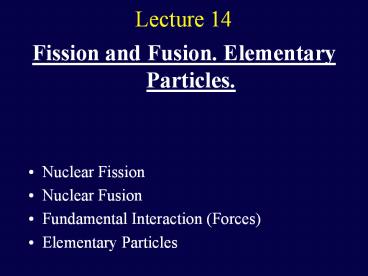Fission and Fusion. Elementary Particles. - PowerPoint PPT Presentation
Title:
Fission and Fusion. Elementary Particles.
Description:
Almost each elementary particle has an antiparticle, that has the same mass, but ... When a particle and its antiparticle come together, they destroy each other ... – PowerPoint PPT presentation
Number of Views:167
Avg rating:3.0/5.0
Title: Fission and Fusion. Elementary Particles.
1
Lecture 14
- Fission and Fusion. Elementary Particles.
- Nuclear Fission
- Nuclear Fusion
- Fundamental Interaction (Forces)
- Elementary Particles
2
Nuclear Fission
In 1939 was discovered that a 23592U nucleus
undergoes fission when struck by a
neutron. 23592U n ? 23692U ? 9438Sr 14054 Xe
?-rays n
Products of fission reactions are radioactive
with long half-lives.
2?3 neutrons are released in a fission act and
can cause other atoms of uranium to split ? a
chain reaction occurs.
A chain reaction was first demonstrated in 1942
(Fermi).
3
Chain Fission Reaction
- If not each neutron produces a U split, the
reaction dies. - If each neutron stimulates 1 split, the reaction
is sustained. - If more than 1 neutron from each fission act
causes other fissions, the reaction is out of
control - explosion.
Natural uranium contains 0.7 of the fissionable
isotope U-235. The rest is U-238 which does not
undergo fission. It captures fast neutrons from
the reaction, but not slow ones. If the fast
neutrons are slowed down, they will produce more
fissions.
4
Plutonium
Fissionable nuclides can be created from
non?fissionable ones by absorbing neutrons.
238U n ? 239U ? 239Np e? ? 239Pl
Neptumium (93Np) and Plutonium (94Pl) are
transuranium elements.
Plutonium is produced in a uranium-fueled reactor
and can serve a reactor fuel itself.
5
Nuclear Fusion
Fusion of small nuclei to form large ones can
give out even more energy per unit mass of
starting material.
Three condition for a fusion reactor High
temperature (100 million K) - fast collisions
High concentration of the nuclei - frequent
collisions Long time of operation - positive
energy balance
21H 31H ? 42He n 17.6 MeV
2 practical approaches to fusion Strong magnetic
fields hold the particles together. Using
energetic beams to both heat and compress small
DT-pellets.
6
Elementary particles
Protons, neutrons, and electrons are elementary
particles.
Protons and neutrons consist of quarks, smaller
particles.
Almost each elementary particle has an
antiparticle, that has the same mass, but the
electric charge of an opposite sign (e? and e,
electron and positron).
When a particle and its antiparticle come
together, they destroy each other
(annihilation). The lost mass reappears as energy
in the form of ? rays.
7
Fundamental Interactions
Elementary particles interact with each other in
4 ways.
The strong interaction holds protons and neutrons
together. The strong force acts over sizes of
10?15 cm. Electrons are not affected by the
strong interaction.
The electromagnetic interaction, which gives rise
to electric and magnetic forces between charged
particles. It is responsible for the structure of
matter. It is 100 times weaker than the strong
interaction at short distances, but is unlimited
in range and acts on electrons.
8
Fundamental Interactions
The weak interaction, which affects all particles
and helps determine the compositions of atomic
nuclei (beta-decay). It acts over a shorter range
than the strong interaction and 10 trillion times
weaker.
The gravitational interaction, responsible for
the attractive force one mass exerts on
another. It dominates on a large scale and is the
weakest on the smallest scales.
9
Leptons and Hadrons
All elementary particles fall into 2 broad
categories with respect to their response to the
strong interaction.
Leptons (light) are not affected and seem to be
point particles with no internal structure
(electron).
Hadrons (heavy) are affected by the strong
interaction, have definite sizes (10?15 cm), and
have structure (proton and neutron).
10
Quarks
Quarks are particles which make up hadrons.
Only 6 kinds of quarks are needed to account for
all hadrons.
The proton, neutron, and heavier hadrons consist
of 3 quarks. Quarks have fractional electric
charges ?1/3e and ?2/3e. They do not seem to
exist outside hadrons. All the evidence for
quarks is indirect, but the theory correctly
predicts new hadrons.
11
Summary
Fission reactions are controllable, produce a lot
of energy, and radioactive waste. Fusion
reactions produce even more energy, but much
harder to control. There are only 4 fundamental
interactions between elementary particles
strong, weak, electromagnetic, and
gravitational. Quarks are building blocks for
hadrons, but have not been detected yet.































